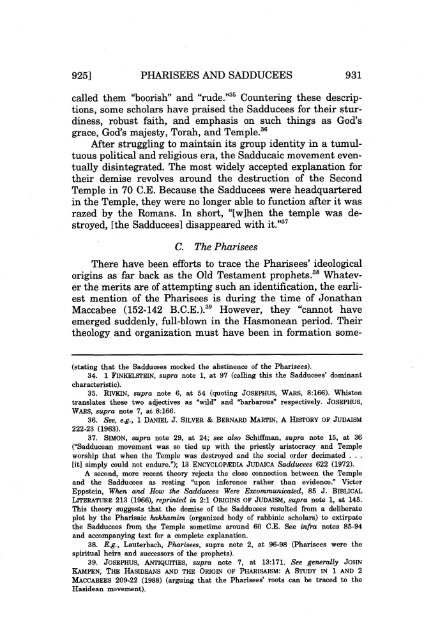The Pharisees and the Sadducees: Rethinking Their Respective ...
The Pharisees and the Sadducees: Rethinking Their Respective ...
The Pharisees and the Sadducees: Rethinking Their Respective ...
Create successful ePaper yourself
Turn your PDF publications into a flip-book with our unique Google optimized e-Paper software.
9251 PHARISEES AND SADDUCEES 931<br />
called <strong>the</strong>m "boorish" <strong>and</strong> "rude."35 Countering <strong>the</strong>se descriptions,<br />
some scholars have praised <strong>the</strong> <strong>Sadducees</strong> for <strong>the</strong>ir sturdiness,<br />
robust faith, <strong>and</strong> emphasis on such things as God's<br />
grace, God's majesty, Torah, <strong>and</strong> Temple.36<br />
After struggling to maintain its group identity -in a tumultuous<br />
political <strong>and</strong> religious era, <strong>the</strong> Sadducaic movement eventually<br />
disintegrated. <strong>The</strong> most widely accepted explanation for<br />
<strong>the</strong>ir demise revolves around <strong>the</strong> destruction of <strong>the</strong> Second<br />
Temple in 70 C.E. Because <strong>the</strong> <strong>Sadducees</strong> were headquartered<br />
in <strong>the</strong> Temple, <strong>the</strong>y were no longer able to function after it was<br />
razed by <strong>the</strong> Romans. In short, "[wlhen <strong>the</strong> temple was destroyed,<br />
[<strong>the</strong> <strong>Sadducees</strong> J disappeared with it."37<br />
C. <strong>The</strong> <strong>Pharisees</strong><br />
<strong>The</strong>re have been efforts to trace <strong>the</strong> <strong>Pharisees</strong>' ideological<br />
origins as far back as <strong>the</strong> Old Testament prophets.38 Whatev-<br />
er <strong>the</strong> merits are of attempting such an identification, <strong>the</strong> earli-<br />
est mention of <strong>the</strong> <strong>Pharisees</strong> is during <strong>the</strong> time of Jonathan<br />
Maccabee (152-142 B.C.E.).3g However, <strong>the</strong>y "cannot have<br />
emerged suddenly, full-blown in <strong>the</strong> Hasmonean period. <strong>The</strong>ir<br />
<strong>the</strong>ology <strong>and</strong> organization must have been in formation some-<br />
(stating that <strong>the</strong> <strong>Sadducees</strong> mocked <strong>the</strong> abstinence of <strong>the</strong> <strong>Pharisees</strong>).<br />
34. 1 FINKELSTEIN, supra note 1, at 97 (calling this <strong>the</strong> <strong>Sadducees</strong>' dominant<br />
characteristic).<br />
35. RIVKIN, supra note 6, at 54 (quoting JOSEPHUS, WARS, 8:166). Whiston<br />
translates <strong>the</strong>se two adjectives as "wild" <strong>and</strong> "barbarous" respectively. JOSEPHUS,<br />
WARS, supra note 7, at 8:166.<br />
36. See, e.g., 1 DANIEL J. SILVER & BERNARD MARTIN, A HISTORY OF JUDAISM<br />
222-23 (1963).<br />
37. SIMON, supra note 29, at 24; see also Schiffman, supra note 15, at 36<br />
("Sadducean movement was so tied up with <strong>the</strong> priestly aristocracy <strong>and</strong> Temple<br />
worship that when <strong>the</strong> Temple was destroyed <strong>and</strong> <strong>the</strong> social order decimated . . .<br />
[it] simply could not endure."); 13 ENCYCLOPEDIA JUDAICA <strong>Sadducees</strong> 622 (1972).<br />
A second, more recent <strong>the</strong>ory rejects <strong>the</strong> close connection between <strong>the</strong> Temple<br />
<strong>and</strong> <strong>the</strong> <strong>Sadducees</strong> as resting "upon inference ra<strong>the</strong>r than evidence." Victor<br />
Eppstein, When <strong>and</strong> How <strong>the</strong> <strong>Sadducees</strong> Were Excommunicated, 85 J. BIBLICAL<br />
LITERATURE 213 (1966), reprinted in 2:l ORIGINS OF JUDAISM, supra note 1, at 145.<br />
This <strong>the</strong>ory suggests that <strong>the</strong> demise of <strong>the</strong> <strong>Sadducees</strong> resulted from a deliberate<br />
plot by <strong>the</strong> Pharisaic hakhamim (organized body of rabbinic scholars) to extirpate<br />
<strong>the</strong> <strong>Sadducees</strong> from <strong>the</strong> Temple sometime around 60 C.E. See infra notes 85-94<br />
<strong>and</strong> accompanying text for a complete explanation.<br />
38. E.g., Lauterbach, <strong>Pharisees</strong>, supra note 2, at 96-98 (<strong>Pharisees</strong> were <strong>the</strong><br />
spiritual heirs <strong>and</strong> successors of <strong>the</strong> prophets).<br />
39. JOSEPHUS, ANTIQUITIES, supra note 7, at 13:171. See generally JOHN<br />
-PEN, THE HASIDEANS AND THE ORIGIN OF PHAFtISAISM: A STUDY IN 1 AND 2<br />
MACCABEES 209-22 (1988) (arguing that <strong>the</strong> <strong>Pharisees</strong>' roots can be traced to <strong>the</strong><br />
Hasidean movement).


